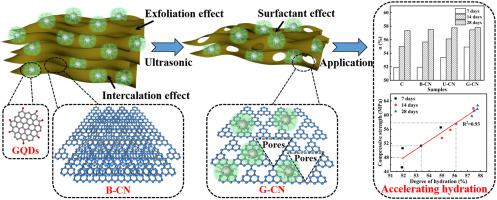Cement and Concrete Composites ( IF 10.8 ) Pub Date : 2022-09-23 , DOI: 10.1016/j.cemconcomp.2022.104782 Wu-Jian Long , Peng Xu , Yang Yu , Feng Xing , Chuang He

|
Tremendous progress has been made in the employment of two-dimensional (2D) nanomaterials in cement composites. However, high cost and poor dispersion of 2D nanomaterials immensely hinder their extensive use. To address these issues, in this work, a scalable, simple, and eco-friendly graphene quantum dots (GQDs)-assisted ultrasonic exfoliation approach was elaborately designed to efficiently delaminate and disperse bulk g-C3N4 (B–CN), thereby obtaining low-cost and high-dispersion CN (G-CN). And the effect of B–CN, B–CN exfoliated without GQDs (U–CN) and G-CN on cement hydration was comprehensively investigated for the first time. Specifically, G-CN possessed a remarkably higher dispersion and a larger specific surface area (32.92 m2 g−1) increasing by 44.45% and 183.55% than U–CN and B–CN, respectively. And based on characteristics of G-CN and properties of GQDs, the exfoliation mechanism of g-C3N4 was ascribed to intercalation, exfoliation, and surfactant effects of GQDs. More importantly, highly dispersed G-CN was more propitious to accelerate cement hydration and refine microstructure, thereby dramatically boosting the compressive strength of cement paste at 7-day curing by 10.1% and 25.0% compared with that of U–CN and B–CN, respectively. This work not only provided a scalable, facile and environmentally-friendly approach to efficiently fabricate well dispersive g-C3N4, but also firstly testified their evident accelerating effect on cement hydration. These findings would be conducive to advancing the application of 2D nanomaterials in cement composites.
中文翻译:

通过 GQDs 辅助超声剥离可扩展制备高分散 g-C3N4 以加速水泥水化
二维(2D)纳米材料在水泥复合材料中的应用取得了巨大进展。然而,二维纳米材料的高成本和较差的分散性极大地阻碍了它们的广泛应用。为了解决这些问题,在这项工作中,精心设计了一种可扩展、简单且环保的石墨烯量子点(GQDs)辅助超声剥离方法,以有效地分层和分散块状 gC 3 N 4 (B-CN),从而获得低成本和高分散CN(G-CN)。并首次全面研究了B-CN、B-CN无GQDs剥离(U-CN)和G-CN对水泥水化的影响。具体而言,G-CN 具有显着更高的分散度和更大的比表面积(32.92 m 2 g -1 ) 分别比 U-CN 和 B-CN 增加 44.45% 和 183.55%。并根据G-CN的特性和GQDs的性质,将gC 3 N 4的剥离机理归结为GQDs的插层、剥离和表面活性作用。更重要的是,高度分散的G-CN更有利于加速水泥水化和细化微观结构,从而使水泥浆体在7天养护时的抗压强度较U-CN和B-CN分别提高10.1%和25.0% , 分别。这项工作不仅提供了一种可扩展、简便且环保的方法来有效地制造分散良好的 gC 3 N 4,还首次证明了它们对水泥水化的明显加速作用。这些发现将有助于推进二维纳米材料在水泥复合材料中的应用。











































 京公网安备 11010802027423号
京公网安备 11010802027423号